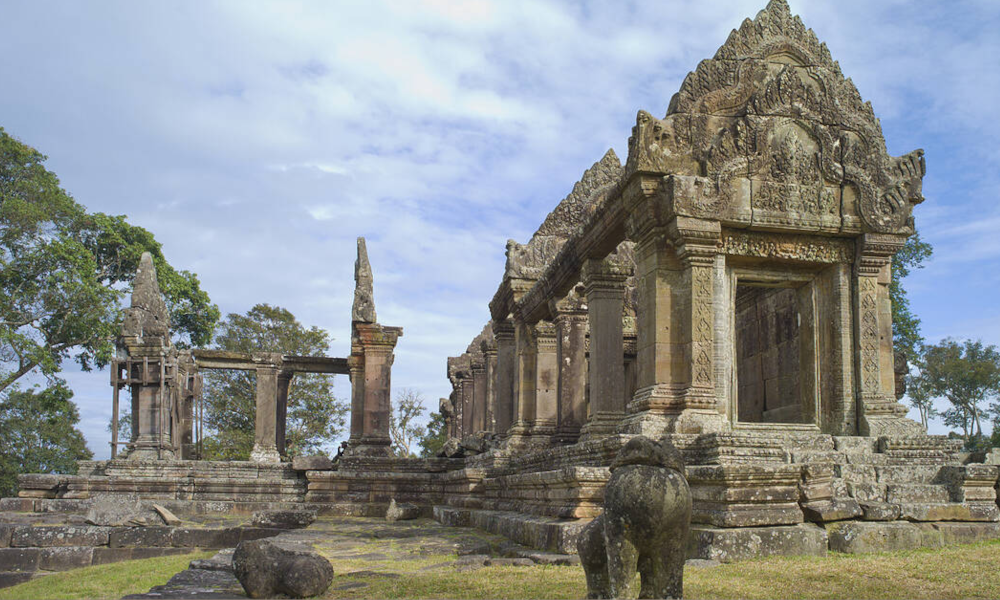Preah Vihear Temple

In the 6th century, King Yasovarman I (889-900) initiated the construction of the original temple dedicated to Shiva, a project that reflected the spiritual growth, enhanced political stature, and economic prosperity of the time. Over more than 300 years, the temple underwent extensive renovations, particularly under King Suryavarman II (1113-1150). This transformation elevated the original modest sanctuary into one of the most significant Khmer temples in history, distinguished by exceptional in situ carvings that exemplified the pinnacle of unique Khmer architectural standards.
Table of Contents
ToggleAccording to the Franco-Siamese Treaty of 1904 and 1907, the border between Cambodia and Thailand along the Dongrak Mountains was established, and the Hague’s ruling confirmed that the Preah Vihear Temple lies within Cambodian territory.
Preah Vihear Temple is situated in a picturesque setting, nestled in the scenic countryside slightly east of the central region of the Dongrek Mountains. It is located on the edge of a cliff, approximately 625 meters above sea level in Preah Vihear Province, in the northern part of Cambodia, about 625 kilometers from the capital city of Phnom Penh, and near the Cambodia-Thailand border.
A brief one-day excursion allows for the exploration of the renowned remote sites, including Preah Vihear Temple, Koh Ker Temple, and Beng Mealea Temple, all...
Layout and Design Preah Vihear
The Preah Vihear temple is organized into three distinct tiers, extending along an 800-meter axis from north to south. This complex features a raised causeway and a series of steps that ascend to the sanctuary situated at the southern end, with the elevation progressively rising by a total of 120 meters from north to south. While its architectural style differs from that of other mountain temples in Cambodia, particularly those at Angkor, Preah Vihear fulfills a similar role in venerating the deities associated with Mount Meru.
Notably, Preah Vihear is characterized by its linear design, which harmoniously aligns with the natural contours of the Dângrêk Mountains. In contrast to the expansive magnificence of Angkor Wat, this temple prioritizes spiritual connection and integration with its environment. The elaborate sandstone carvings that embellish its walls are exemplary works of Khmer craftsmanship, illustrating various myths and religious motifs that enchant visitors.
History of Preah Vihear Temple
The origins of the Preah Vihear Temple can be traced back to the ninth century AD, although the structure that exists today primarily dates from the eleventh century.
Constructed by the rulers of the Khmer Empire, the temple was initially established by King Suryavarman I (1002-1050) and later expanded by Suryavarman II (1113-1150).
The temple comprises a series of sanctuaries known as “gopuras” and features intricately designed stone edifices. One of the most remarkable characteristics of the Preah Vihear Temple is its elevated position atop the Dângrêk Mountains.
Despite its breathtaking setting, this location contributes to the temple being less frequented than other Angkorian sites, such as the more recent Angkor Wat. The ownership of the Preah Vihear Temple has historically been a contentious issue between Cambodia and Thailand, nearly resulting in armed conflict.
Preah Vihear Temple at present: The Preah Vihear Temple is officially located in Cambodia, yet it is more accessible from Thailand. Military personnel from both nations continue to be stationed at the site, which remains a region of considerable tension. In 2008, UNESCO designated the Preah Vihear Temple as a World Heritage site, a decision that sparked significant controversy.
Should Visit or Not
Preah Vihear distinguishes itself from the majority of Khmer temples due to its construction along a north-south axis, in contrast to the conventional rectangular layout that typically faces east. The name Preah Vihear refers both to the temple itself and to the Cambodian province in which it is situated. Conversely, Thailand designates this area as Khao Phra Wihan National Park, which lies on the border of Sisaket province. Access to the temple from the Thai side is restricted for both tourists and local residents.
The optimal time to visit Preah Vihear is during the late and early months of the year, when the climate is characterized by pleasant temperatures and comfortable humidity levels. Given the extensive trekking required, this peak period is particularly suitable for visitors.
Additionally, as the main temple is situated several kilometers from the nearest parking area, visitors must navigate a lengthy path over mountainous terrain, with sparse tree cover along the ascent. Consequently, for those already residing in Preah Vihear province, a morning excursion to Prasat Preah Vihear is highly recommended. During this time, the weather is likely to be cooler and more agreeable, making the trek to the temple more comfortable.
Location & How to Get There
The most convenient route to Preah Vihear is from the town of Sra’em, located 30 kilometers to the south. There are four hotels situated 1 kilometer west of the town center, near the roundabout, along Route 2625. Room rates vary between $7 and $12 (See More at Preah Vihear Province). Moto taxis are available to transport visitors from Sra’em to Preah Vihear Temple, charging $15 per individual, or $10 per person for groups of two or more.

